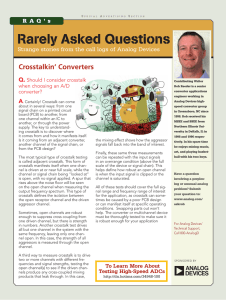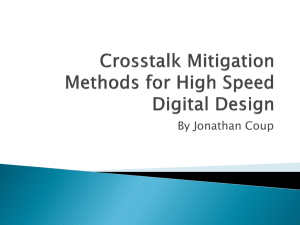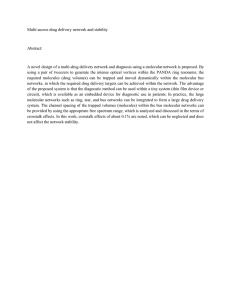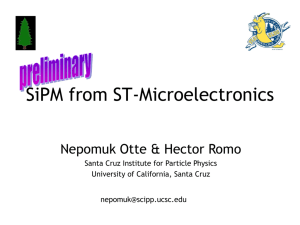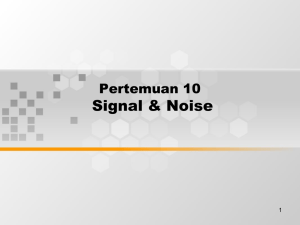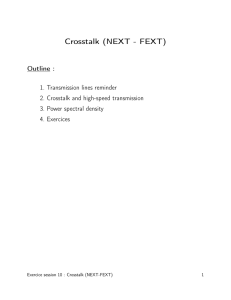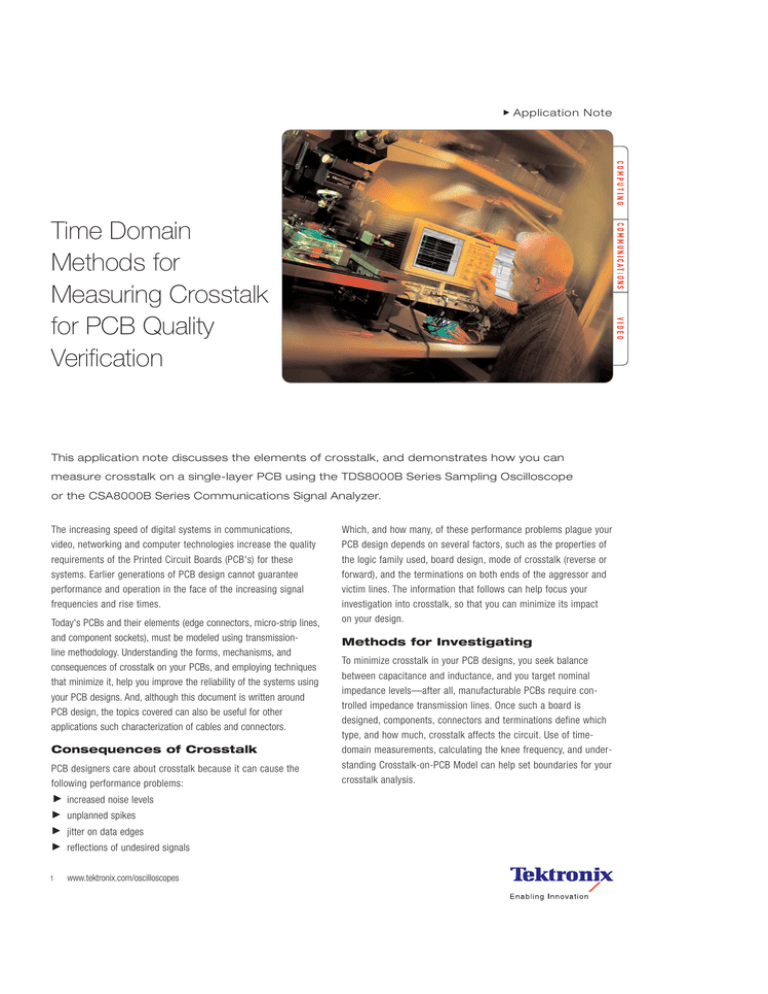
Application Note
Time Domain
Methods for
Measuring Crosstalk
for PCB Quality
Verification
This application note discusses the elements of crosstalk, and demonstrates how you can
measure crosstalk on a single-layer PCB using the TDS8000B Series Sampling Oscilloscope
or the CSA8000B Series Communications Signal Analyzer.
The increasing speed of digital systems in communications,
video, networking and computer technologies increase the quality
requirements of the Printed Circuit Boards (PCB's) for these
systems. Earlier generations of PCB design cannot guarantee
performance and operation in the face of the increasing signal
frequencies and rise times.
Today's PCBs and their elements (edge connectors, micro-strip lines,
and component sockets), must be modeled using transmissionline methodology. Understanding the forms, mechanisms, and
consequences of crosstalk on your PCBs, and employing techniques
that minimize it, help you improve the reliability of the systems using
your PCB designs. And, although this document is written around
PCB design, the topics covered can also be useful for other
applications such characterization of cables and connectors.
Consequences of Crosstalk
PCB designers care about crosstalk because it can cause the
following performance problems:
increased noise levels
unplanned spikes
jitter on data edges
reflections of undesired signals
1
www.tektronix.com/oscilloscopes
Which, and how many, of these performance problems plague your
PCB design depends on several factors, such as the properties of
the logic family used, board design, mode of crosstalk (reverse or
forward), and the terminations on both ends of the aggressor and
victim lines. The information that follows can help focus your
investigation into crosstalk, so that you can minimize its impact
on your design.
Methods for Investigating
To minimize crosstalk in your PCB designs, you seek balance
between capacitance and inductance, and you target nominal
impedance levels—after all, manufacturable PCBs require controlled impedance transmission lines. Once such a board is
designed, components, connectors and terminations define which
type, and how much, crosstalk affects the circuit. Use of timedomain measurements, calculating the knee frequency, and understanding Crosstalk-on-PCB Model can help set boundaries for your
crosstalk analysis.
Time Domain Methods for Measuring Crosstalk for PCB Quality Verification
Application Note
Figure 1. Mutual Impedance between lines on PCB
Figure 2. Capacitively coupled crosstalk
Time-domain Measurements
Crosstalk-on-PCB Model
To measure and analyze crosstalk, you can use frequency-domain
techniques to observe the clock harmonics located in the frequency
spectrum relative to the EMI limit levels at these frequencies.
However, a time-domain measurement of the digital-signal edge—
the rise time from 10% to 90% level—offers these advantages:
The following model sets the stage for exploring the different forms
of crosstalk and illustrates how mutual impedance between the
micro-strip lines causes crosstalk on a PCB. Figure 1 shows the
conceptual model of the mutual impedance, which is evenly distributed along the length of the two lines.
The speed of the digital-signal edge or the rise time directly
describes how high the levels are at each frequency.
Crosstalk begins as a digital gate outputs a rising edge to the
aggressor line, which starts to propagate along the line:
The definition of speed-by-signal-edge (rise time) also helps
explain the mechanisms of crosstalk.
1 Both the mutual capacitance, Cm, and the mutual inductance, Lm,
couple or "crosstalk" a voltage into the adjacent victim line.
Rise time can be used to directly calculate the Knee Frequency,
as explained below.
2 The crosstalk voltage appears on the victim line as a narrow pulse
with a width equal to the pulse rise time on the aggressor line.
This application note demonstrates and measures crosstalk using
rise-time measurements.
3 On the victim line, the pulse divides into two pulses, and each
starts to propagate in opposite directions, effectively dividing
crosstalk into two parts:
Knee Frequency
To guarantee reliable operation of a digital system, you must develop and verify the circuit design for frequencies below the Knee
Frequency. Frequency-domain analysis of a digital signal shows that
frequencies higher than the Knee Frequency are attenuated, so they
have no practical effect on crosstalk, while frequencies below the
Knee Frequency have high enough power to affect the circuit operation. Knee Frequency is calculated with the formula:
0.5
fknee = ————
trise
Forward Crosstalk, propagating in the direction of original
aggressor pulse, and..
Reverse Crosstalk, propagating in the opposite, source direction.
Crosstalk Types and Coupling
Mechanisms
Based on the model just discussed, the information that follows
illustrates the coupling mechanisms of crosstalk and discusses the
two types of crosstalk.
Capacitively Coupled
Mutual capacitance in circuits enables crosstalk as follows:
As the pulse on the aggressor line arrives at the capacitor, the
capacitor couples a narrow pulse to the victim line.
The amplitude of the coupled pulse is defined by the value of the
mutual capacitance.
The coupled pulse divides into two parts, and each starts to
propagate in opposite directions along the victim line.
2
www.tektronix.com/oscilloscopes
Time Domain Methods for Measuring Crosstalk for PCB Quality Verification
Application Note
Figure 3. Inductively coupled crosstalk
Figure 5. Forward Crosstalk
Reverse Crosstalk
The models just described result in the capacitively and inductively coupled crosstalk voltages summing in the victim line at the crosstalk location.
The reverse crosstalk that results includes the following characteristics:
Reverse crosstalk is the sum of two same polarity pulses.
Figure 4. Reverse Crosstalk
As the crosstalk location propagates with the aggressor-pulse
edge, reverse crosstalk is seen at the source of victim line as a
low level, wide pulse, with the width relative to the line length.
Methods for investigating
Reverse crosstalk amplitude is independent of the aggressorpulse rise time but depends on the mutual-impedance value.
To minimize crosstalk in your PCB designs, you seek balance between
capacitance and inductance, and you target nominal impedance levels
—after all, manufacturable PCBs require controlled impedance transmission lines. Once such a board is designed, components, connectors
and terminations define which type, and how much, crosstalk affects
the circuit. Use of time-domain measurements, calculating the knee
frequency, and understanding Crosstalk-on-PCB Model can help set
boundaries for your crosstalk analysis.
Inductively, or Transformer-coupled
Mutual inductance in circuits enables crosstalk as follows:
The pulse propagating on the aggressor line charges the next
location with a current spike.
This current spike induces a magnetic field, which in turn induces
a current spike on the victim line.
The transformer generates two opposite-polarity voltage spikes on
the victim line: the negative spike propagates in the forward direction and the positive spike propagates in the reverse direction.
Forward Crosstalk
Again, the capacitively and inductively coupled crosstalk voltages
sum in the victim line at the crosstalk location. Forward crosstalk
includes the following characteristics:
Forward crosstalk is the sum of two opposite-polarity pulses.
Because the polarities are opposite, the sum depends on the
relative values of the capacitance and inductance.
Forward crosstalk is seen at the end of the victim line as a
narrow spike with width of the aggressor rise time.
Forward crosstalk depends on the rise time of the aggressorpulse rise time—the faster the rising edge, the higher the
amplitude and narrower the shape.
Forward crosstalk amplitude also depends on the paired lines length:
as the crosstalk location propagates along the aggressor-pulse edge,
the forward-crosstalk pulse in the victim line receives more energy.
www.tektronix.com/oscilloscopes
3
Time Domain Methods for Measuring Crosstalk for PCB Quality Verification
Application Note
Characterizing Crosstalk
The information that follows explores the crosstalk mechanisms and
types just described by making several example measurements on a
single-layer PCB by making example measurements.
Note: To become familiar with the crosstalk issues and consequences that
come with multilayer PCBs and their ground layers, refer to the reference
materials and other sources at the end of this application note.
Instrumentation and Setup
To effectively measure crosstalk in a laboratory, use a wide-bandwidth oscilloscope with 20 GHz measuring bandwidth. Drive the
circuits under test from a high-quality pulse generator that outputs
a pulse rise time that equals the rise time of the oscilloscope. Use
high-quality cables, termination resistors, and adapters with your
PCB under test.
Figure 6. Forward Crosstalk Measurement
The Tektronix 8000B Series instrument, with the 80E04 Electrical
Sampling Module installed, makes an ideal combination for successfully measuring crosstalk. The 80E04 is a dual-channel sampling
module contains a TDR step generator that generates 17 ps
rise-time pulses with a 250 mV amplitude from a 50 Ω source
impedance. You need only connect the PCB that you wish to test.
Measuring Forward Crosstalk
To measure forward crosstalk only, all the lines are terminated to
eliminate reflections. The measurement is made at the end of the
terminated victim line. The setup, shown in Figure 6, follows.
If the mutual inductance couples more crosstalk than the mutual
capacitance, the pulse is negative at positive-aggressor edge. The
width is the rise time of the aggressor edge. The instrument displays negative pulse (C4) with 48.45 mV amplitude. The aggressor
amplitude is 250 mV, and the crosstalk is almost 50 mV, so this fast
edge causes 20% crosstalk on these lines. See Figure 7.
Because the input step from 80E04 is an extremely fast edge, the
measured crosstalk that results is too high to represent driving
signals present in practical logic families. For example, if the drive
signal was from a 1.5 ns CMOS gate, the crosstalk pulse would be
much wider and lower. To represent this case, the Define Math feature of the instrument is used to create a low-pass filter after the
acquisition. The M1 waveform (white ) in Figure 7 shows the results.
Note that the vertical setting for M1 is 10 times more sensitive than
that for the nonfiltered waveform.
Although mathematical analysis proves the technique just described
leads to the same result as physically filtering an agressor pulse connected to the line, the following steps further validate the equivalence:
4
www.tektronix.com/oscilloscopes
Figure 7. Forward Crosstalk Measured
Measure the crosstalks caused by a fast and a slow edge with the
same amplitude.
Then low-pass filter the crosstalk from the fast edge to the rise
time of the slow edge, and verify the results.
The resulting measurements are displayed on the instrument screen
shown in Figure 8, and are as follows:
The red waveform (R3) is the crosstalk caused by the slow generator pulse, which is the yellow waveform (R2).
The white waveform (R4) is the crosstalk caused by the fast TDR
pulse, which is the green waveform (R1).
The blue waveform (M1) is filtered from the white waveform to
slow down the pulse rise time, and represents the crosstalk using
post-filtering. These two crosstalk traces are displayed at the
same voltage scale.
Time Domain Methods for Measuring Crosstalk for PCB Quality Verification
Application Note
Figure 8. Post-Filtering of Forward Crosstalk
Figure 10. Reverse Crosstalk Measured
Figure 9. Measurement of Reverse Crosstalk
Measuring Reverse Crosstalk
To measure reverse crosstalk only, both lines are terminated with a
50 Ω resistor to eliminate reflections, with the measurement taken
at the left end of the victim line, as shown in Figure 9.
The amplitude of the returning pulse is low and its width represents
twice the length of the line, because the crosstalk from the end of the
line must travel back to the source. Figure 10 displays this measurement, where crosstalk from fast edge is about 10 mV, which equals 4%.
The amplitude of the reverse crosstalk is independent of the
aggressor rise time. The two lower waveforms in Figure 10 are
crosstalk from a slow pulse and the post-filtered crosstalk of the
fast pulse. These both have about 6.5 mV amplitude. The length of
the line compared to the rise time causes the lower amplitude of
this slow pulse. In this case, the rise time is longer than the line,
and the edge propagates through the line before the edge reaches
full amplitude. Figure 11 shows crosstalk measurements from a 200
ps rise-time generator (DG2040) and from the 17 ps generator of
the 80E04 sampling module.
Figure 11. Reverse Crosstalk is independent of rise time
The three crosstalk waveforms in Figure 11 are at the same voltage
scale, 5 mV/div. The white waveform is the result of the 17 ps
crosstalk, post-filtered by a waveform math function to 200 ps rise
time. These results confirm that aggressor rise time does not affect
reverse crosstalk, unless the rise time is longer than the line. If the
aggressor rise time is longer than the line, the crosstalk will be lower in
amplitude since the edge does not reach full amplitude over the line.
Effects of Circuit Design on Crosstalk
Although careful design of the PCB reduces crosstalk and reduces
or removes its effects, some crosstalk will likely remain on PCBs.
Careful circuit design should apply proper line-end terminations,
because these terminations affect the amount of, and time decay
of, crosstalk. The measurement examples that follow illustrate how
line terminations at the end of the line and at logic gate output
attenuate crosstalk and its causes.
www.tektronix.com/oscilloscopes
5
Time Domain Methods for Measuring Crosstalk for PCB Quality Verification
Application Note
Figure 12. Crosstalk without end termination
Figure 14. Crosstalk with both ends unterminated
Figure 13. Measured crosstalk without end termination
Figure 15. Measured crosstalk with both lines unterminated
Effects of No End Termination
Effects on No Source or End Terminations
To measure one case of no end termination, the aggressor line is
left unterminated. This setup simulates a line without a terminating
resistor driving a CMOS gate, since the CMOS gate has a very high
input impedance compared to the 50 Ω nominal line impedance of
the line, as shown in Figure 12.
To examine a second case of no termination, both the aggressor line
is left open, with no end termination, and victim line is left open,
with no source termination. In this case, reverse and forward
crosstalk and the reflections accumulate, causing an increase of
noise voltage on the victim line, as shown in Figure 14. (Similar
voltages can be assumed to occur on adjacent lines as well.)
The circuit responds by reflecting the arriving pulse from the open
end of the transmission line back to the source, with full amplitude
and the same polarity. If the source is terminated, no second reflection occurs there. The measurement at the end of the victim line
includes two basic phenomena: the original forward crosstalk, a
narrow spike, followed by reverse crosstalk manifested as low and
wide pulse caused by the reflected pulse. Figure 13 displays these
pulses together (C4), with the aggressor pulse reflection measured
at the source of the aggressor line (C3).
6
www.tektronix.com/oscilloscopes
Victim line end (Z) has a spike from the original forward crosstalk,
followed by the reverse crosstalk from the first reflection in the
aggressor line (X). The original victim line reverse crosstalk reflected
from the open source (Y) will then sum up at the same time with (X)
causing double voltage to the wide pulse! In addition, all the forward
crosstalk narrow spikes will bounce back and forth from the open
ends. Figure 15 displays these waveforms.
Time Domain Methods for Measuring Crosstalk for PCB Quality Verification
Application Note
Conclusion
TDR-capable instruments, such as 8000B series instruments
equipped with the 80E04 Electrical sampling module, used with the
methods and approaches explored in this application note, can meet
the design challenges presented by crosstalk. Using the measurements discussed here on your prototype will help verify that your
design handles these challenges. Careful measurements of
crosstalk effects, and application of correct working terminations,
are keys to eliminating the consequences of crosstalk.
Figure 16. Crosstalk with low impedance source
Tektronix CSA8000B Series Communication Signal Analyzers and
TDS8000B Series Sampling Oscilloscopes support design and
verification of extremely fast electronic circuits. Some of these
applications follow:
Crosstalk measurements on PCB’s and cablings, using the 80E04
Electrical Sampling Module to generate 17 ps rise-time steps and
the mathematical functions of the 8000B Series instruments to
simulate practical circuit speeds.
Impedance measurement and analysis of the interconnects, transmission lines, and micro strip lines, using TDR technology. The
8000B series provides 17 ps rise time and 20 GHz bandwidth,
resulting in 3-mm resolution on ordinary PCB materials.
AC parameter measurements of electronics to verify fundamental
operation of extremely high speed logic gates. A +70 GHz bandwidth and multi-channel construction with a very stable time
base enable accurate and flexible measurements, including jitter
down to less than 1 ps.
Figure 17. Measured crosstalk with victim source shorted
Note. When making measurements like just described, terminate all
unused lines to keep noise level low. Otherwise, crosstalk pulses from
these lines will couple to, and create further crosstalk in, their victim lines.
Measurements of optical interfaces in communication technologies, using standard receivers and optical sampling inputs. The
8000B Series instruments feature onboard automatic measurements for optical signals, when used with 80C00 Series Optical
Sampling Modules.
Effects of Low Impedance Source
To examine the case of a low impedance source on the victim line,
the victim line is driven by an ECL gate. The gate is simulated in the
measurement setup using a shorting termination. (Fast ECL gate
output impedance ranges from 15 Ω to 25 Ω). The measurement
setup is shown in Figure 16.
The ECL gate impedance and line impedance mismatch results in
negative reflections in the aggressor line. If the aggressor line carries a pulse, its reverse crosstalk will reflect to its victim line with
negative polarity. The reflection appears as a negative pulse at the
end of the victim line, as shown Figure 17.
www.tektronix.com/oscilloscopes
7
Contact Tektronix:
The author:
ASEAN / Australasia / Pakistan (65) 6356 3900
Tuomo Heikkilä
Systems Applications Engineer
Applications Project Center
Tektronix Oy, Finland
Austria +43 2236 8092 262
Belgium +32 (2) 715 89 70
Brazil & South America 55 (11) 3741-8360
Canada 1 (800) 661-5625
Central Europe & Greece +43 2236 8092 301
tuomo.heikkila@tek.com
Denmark +45 44 850 700
Finland +358 (9) 4783 400
References:
France & North Africa +33 (0) 1 69 86 80 34
Germany +49 (221) 94 77 400
Howard Johnson and Martin Graham: ”High Speed Digital Design”,
Prentice Hall, ISBN 0-13-395724-1, 1993.
Hong Kong (852) 2585-6688
India (91) 80-2275577
Italy +39 (02) 25086 1
Mark D Tilden: “Measuring Controlled Impedance Boards with TDR”,
Tektronix Inc. Application Note, 85W-8531-0, 1992
Japan 81 (3) 3448-3010
Mexico, Central America & Caribbean 52 (55) 56666-333
Tektronix Inc.: “11800/CSA803 Using Filtering to Control Rise Time”,
Application Note, 85W-6893-0, 1993.
The Netherlands +31 (0) 23 569 5555
Norway +47 22 07 07 00
People’s Republic of China 86 (10) 6235 1230
Tektronix Inc.: “TDR Tools in Modeling Interconnects and Packages”,
Application Note.
Poland +48 (0) 22 521 53 40
Republic of Korea 82 (2) 528-5299
Russia, CIS & The Baltics +358 (9) 4783 400
South Africa +27 11 254 8360
Spain +34 (91) 372 6055
Sweden +46 8 477 6503/4
Taiwan 886 (2) 2722-9622
United Kingdom & Eire +44 (0) 1344 392400
USA 1 (800) 426-2200
USA (Export Sales) 1 (503) 627-1916
For other areas contact Tektronix, Inc. at: 1 (503) 627-7111
Updated 20 September 2002
For Further Information
contact your nearest Tektronix representative.
Copyright © 2003, Tektronix, Inc. All rights reserved. Tektronix products are covered by U.S. and
foreign patents, issued and pending. Information in this publication supersedes that in all previously
published material. Specification and price change privileges reserved. TEKTRONIX and TEK
are registered trademarks of Tektronix, Inc. All other trade names referenced are the service marks,
trademarks or registered trademarks of their respective companies.
06/03 MD/SFI
85W-16643-0
8
www.tektronix.com/oscilloscopes

